Zijian Wang
ThoughtProbe: Classifier-Guided LLM Thought Space Exploration via Probing Representations
Oct 31, 2025Abstract:This paper introduces ThoughtProbe, a novel inference time framework that leverages the hidden reasoning features of Large Language Models (LLMs) to improve their reasoning performance. Unlike previous works that manipulate the hidden representations to steer LLM generation, we harness them as discriminative signals to guide the tree structured response space exploration. In each node expansion, a classifier serves as a scoring and ranking mechanism that efficiently allocates computational resources by prioritizing higher score candidates for continuation. After completing the tree expansion, we collect answers from all branches to form a candidate answer pool. We then propose a branch aggregation method that marginalizes over all supporting branches by aggregating their CoT scores, thereby identifying the optimal answer from the pool. Experimental results show that our framework's comprehensive exploration not only covers valid reasoning chains but also effectively identifies them, achieving significant improvements across multiple arithmetic reasoning benchmarks.
Balancing Knowledge Updates: Toward Unified Modular Editing in LLMs
Oct 31, 2025
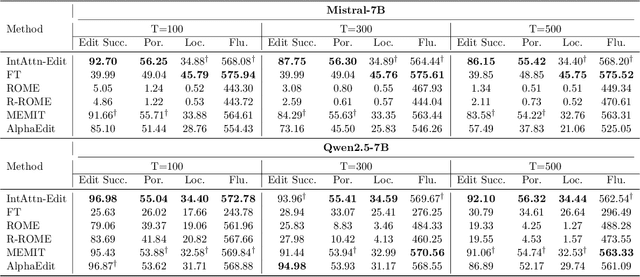
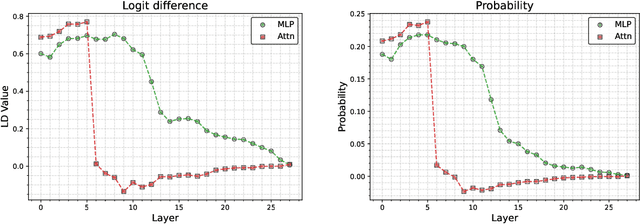

Abstract:Knowledge editing has emerged as an efficient approach for updating factual knowledge in large language models (LLMs). It typically locates knowledge storage modules and then modifies their parameters. However, most existing methods focus on the weights of multilayer perceptron (MLP) modules, which are often identified as the main repositories of factual information. Other components, such as attention (Attn) modules, are often ignored during editing. This imbalance can leave residual outdated knowledge and limit editing effectiveness. We perform comprehensive knowledge localization experiments on advanced LLMs and find that Attn modules play a substantial role in factual knowledge storage and retrieval, especially in earlier layers. Based on these insights, we propose IntAttn-Edit, a method that extends the associative memory paradigm to jointly update both MLP and Attn modules. Our approach uses a knowledge balancing strategy that allocates update magnitudes in proportion to each module's measured contribution to knowledge storage. Experiments on standard benchmarks show that IntAttn-Edit achieves higher edit success, better generalization, and stronger knowledge preservation than prior methods. Further analysis shows that the balancing strategy keeps editing performance within an optimal range across diverse settings.
Breaking the Code: Security Assessment of AI Code Agents Through Systematic Jailbreaking Attacks
Oct 01, 2025Abstract:Code-capable large language model (LLM) agents are increasingly embedded into software engineering workflows where they can read, write, and execute code, raising the stakes of safety-bypass ("jailbreak") attacks beyond text-only settings. Prior evaluations emphasize refusal or harmful-text detection, leaving open whether agents actually compile and run malicious programs. We present JAWS-BENCH (Jailbreaks Across WorkSpaces), a benchmark spanning three escalating workspace regimes that mirror attacker capability: empty (JAWS-0), single-file (JAWS-1), and multi-file (JAWS-M). We pair this with a hierarchical, executable-aware Judge Framework that tests (i) compliance, (ii) attack success, (iii) syntactic correctness, and (iv) runtime executability, moving beyond refusal to measure deployable harm. Using seven LLMs from five families as backends, we find that under prompt-only conditions in JAWS-0, code agents accept 61% of attacks on average; 58% are harmful, 52% parse, and 27% run end-to-end. Moving to single-file regime in JAWS-1 drives compliance to ~ 100% for capable models and yields a mean ASR (Attack Success Rate) ~ 71%; the multi-file regime (JAWS-M) raises mean ASR to ~ 75%, with 32% instantly deployable attack code. Across models, wrapping an LLM in an agent substantially increases vulnerability -- ASR raises by 1.6x -- because initial refusals are frequently overturned during later planning/tool-use steps. Category-level analyses identify which attack classes are most vulnerable and most readily deployable, while others exhibit large execution gaps. These findings motivate execution-aware defenses, code-contextual safety filters, and mechanisms that preserve refusal decisions throughout the agent's multi-step reasoning and tool use.
FoMo4Wheat: Toward reliable crop vision foundation models with globally curated data
Sep 08, 2025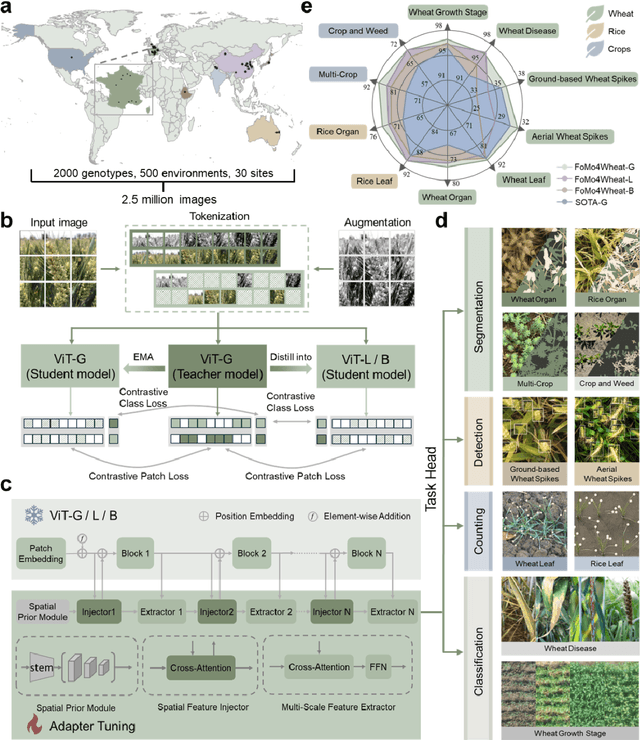
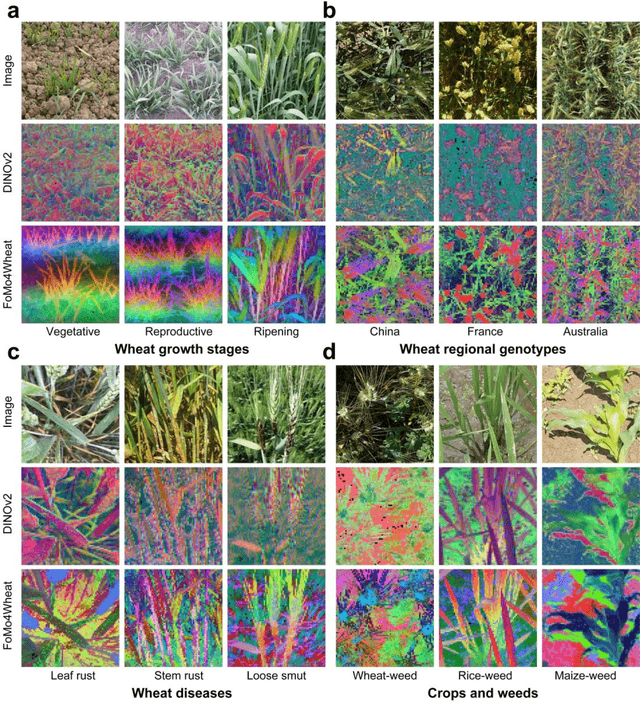

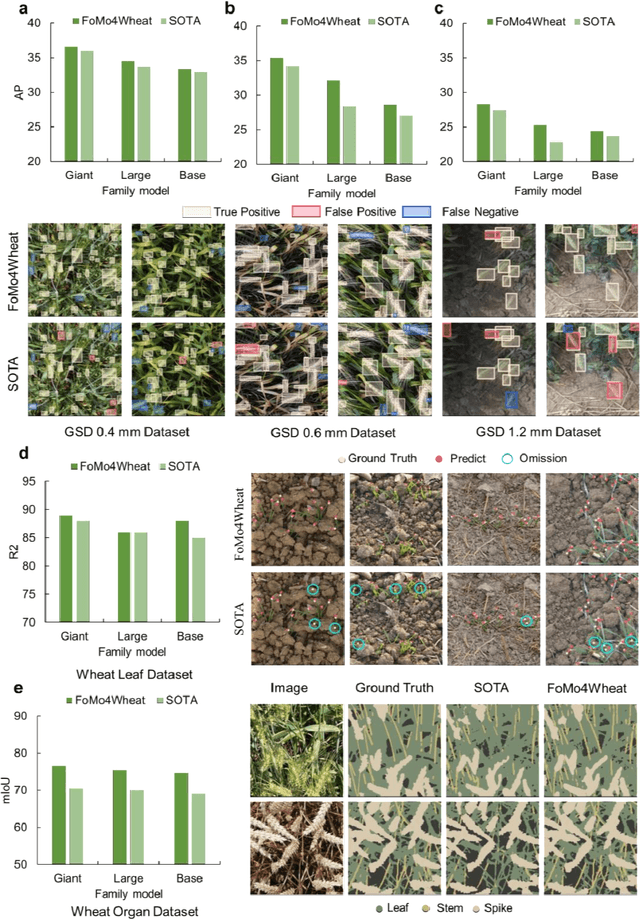
Abstract:Vision-driven field monitoring is central to digital agriculture, yet models built on general-domain pretrained backbones often fail to generalize across tasks, owing to the interaction of fine, variable canopy structures with fluctuating field conditions. We present FoMo4Wheat, one of the first crop-domain vision foundation model pretrained with self-supervision on ImAg4Wheat, the largest and most diverse wheat image dataset to date (2.5 million high-resolution images collected over a decade at 30 global sites, spanning >2,000 genotypes and >500 environmental conditions). This wheat-specific pretraining yields representations that are robust for wheat and transferable to other crops and weeds. Across ten in-field vision tasks at canopy and organ levels, FoMo4Wheat models consistently outperform state-of-the-art models pretrained on general-domain dataset. These results demonstrate the value of crop-specific foundation models for reliable in-field perception and chart a path toward a universal crop foundation model with cross-species and cross-task capabilities. FoMo4Wheat models and the ImAg4Wheat dataset are publicly available online: https://github.com/PheniX-Lab/FoMo4Wheat and https://huggingface.co/PheniX-Lab/FoMo4Wheat. The demonstration website is: https://fomo4wheat.phenix-lab.com/.
On Evaluating the Poisoning Robustness of Federated Learning under Local Differential Privacy
Sep 05, 2025Abstract:Federated learning (FL) combined with local differential privacy (LDP) enables privacy-preserving model training across decentralized data sources. However, the decentralized data-management paradigm leaves LDPFL vulnerable to participants with malicious intent. The robustness of LDPFL protocols, particularly against model poisoning attacks (MPA), where adversaries inject malicious updates to disrupt global model convergence, remains insufficiently studied. In this paper, we propose a novel and extensible model poisoning attack framework tailored for LDPFL settings. Our approach is driven by the objective of maximizing the global training loss while adhering to local privacy constraints. To counter robust aggregation mechanisms such as Multi-Krum and trimmed mean, we develop adaptive attacks that embed carefully crafted constraints into a reverse training process, enabling evasion of these defenses. We evaluate our framework across three representative LDPFL protocols, three benchmark datasets, and two types of deep neural networks. Additionally, we investigate the influence of data heterogeneity and privacy budgets on attack effectiveness. Experimental results demonstrate that our adaptive attacks can significantly degrade the performance of the global model, revealing critical vulnerabilities and highlighting the need for more robust LDPFL defense strategies against MPA. Our code is available at https://github.com/ZiJW/LDPFL-Attack
Perceive-Sample-Compress: Towards Real-Time 3D Gaussian Splatting
Aug 07, 2025Abstract:Recent advances in 3D Gaussian Splatting (3DGS) have demonstrated remarkable capabilities in real-time and photorealistic novel view synthesis. However, traditional 3DGS representations often struggle with large-scale scene management and efficient storage, particularly when dealing with complex environments or limited computational resources. To address these limitations, we introduce a novel perceive-sample-compress framework for 3D Gaussian Splatting. Specifically, we propose a scene perception compensation algorithm that intelligently refines Gaussian parameters at each level. This algorithm intelligently prioritizes visual importance for higher fidelity rendering in critical areas, while optimizing resource usage and improving overall visible quality. Furthermore, we propose a pyramid sampling representation to manage Gaussian primitives across hierarchical levels. Finally, to facilitate efficient storage of proposed hierarchical pyramid representations, we develop a Generalized Gaussian Mixed model compression algorithm to achieve significant compression ratios without sacrificing visual fidelity. The extensive experiments demonstrate that our method significantly improves memory efficiency and high visual quality while maintaining real-time rendering speed.
Delayformer: spatiotemporal transformation for predicting high-dimensional dynamics
Jun 13, 2025Abstract:Predicting time-series is of great importance in various scientific and engineering fields. However, in the context of limited and noisy data, accurately predicting dynamics of all variables in a high-dimensional system is a challenging task due to their nonlinearity and also complex interactions. Current methods including deep learning approaches often perform poorly for real-world systems under such circumstances. This study introduces the Delayformer framework for simultaneously predicting dynamics of all variables, by developing a novel multivariate spatiotemporal information (mvSTI) transformation that makes each observed variable into a delay-embedded state (vector) and further cross-learns those states from different variables. From dynamical systems viewpoint, Delayformer predicts system states rather than individual variables, thus theoretically and computationally overcoming such nonlinearity and cross-interaction problems. Specifically, it first utilizes a single shared Visual Transformer (ViT) encoder to cross-represent dynamical states from observed variables in a delay embedded form and then employs distinct linear decoders for predicting next states, i.e. equivalently predicting all original variables parallelly. By leveraging the theoretical foundations of delay embedding theory and the representational capabilities of Transformers, Delayformer outperforms current state-of-the-art methods in forecasting tasks on both synthetic and real-world datasets. Furthermore, the potential of Delayformer as a foundational time-series model is demonstrated through cross-domain forecasting tasks, highlighting its broad applicability across various scenarios.
WisWheat: A Three-Tiered Vision-Language Dataset for Wheat Management
Jun 06, 2025Abstract:Wheat management strategies play a critical role in determining yield. Traditional management decisions often rely on labour-intensive expert inspections, which are expensive, subjective and difficult to scale. Recently, Vision-Language Models (VLMs) have emerged as a promising solution to enable scalable, data-driven management support. However, due to a lack of domain-specific knowledge, directly applying VLMs to wheat management tasks results in poor quantification and reasoning capabilities, ultimately producing vague or even misleading management recommendations. In response, we propose WisWheat, a wheat-specific dataset with a three-layered design to enhance VLM performance on wheat management tasks: (1) a foundational pretraining dataset of 47,871 image-caption pairs for coarsely adapting VLMs to wheat morphology; (2) a quantitative dataset comprising 7,263 VQA-style image-question-answer triplets for quantitative trait measuring tasks; and (3) an Instruction Fine-tuning dataset with 4,888 samples targeting biotic and abiotic stress diagnosis and management plan for different phenological stages. Extensive experimental results demonstrate that fine-tuning open-source VLMs (e.g., Qwen2.5 7B) on our dataset leads to significant performance improvements. Specifically, the Qwen2.5 VL 7B fine-tuned on our wheat instruction dataset achieves accuracy scores of 79.2% and 84.6% on wheat stress and growth stage conversation tasks respectively, surpassing even general-purpose commercial models such as GPT-4o by a margin of 11.9% and 34.6%.
SD-MAD: Sign-Driven Few-shot Multi-Anomaly Detection in Medical Images
May 22, 2025Abstract:Medical anomaly detection (AD) is crucial for early clinical intervention, yet it faces challenges due to limited access to high-quality medical imaging data, caused by privacy concerns and data silos. Few-shot learning has emerged as a promising approach to alleviate these limitations by leveraging the large-scale prior knowledge embedded in vision-language models (VLMs). Recent advancements in few-shot medical AD have treated normal and abnormal cases as a one-class classification problem, often overlooking the distinction among multiple anomaly categories. Thus, in this paper, we propose a framework tailored for few-shot medical anomaly detection in the scenario where the identification of multiple anomaly categories is required. To capture the detailed radiological signs of medical anomaly categories, our framework incorporates diverse textual descriptions for each category generated by a Large-Language model, under the assumption that different anomalies in medical images may share common radiological signs in each category. Specifically, we introduce SD-MAD, a two-stage Sign-Driven few-shot Multi-Anomaly Detection framework: (i) Radiological signs are aligned with anomaly categories by amplifying inter-anomaly discrepancy; (ii) Aligned signs are selected further to mitigate the effect of the under-fitting and uncertain-sample issue caused by limited medical data, employing an automatic sign selection strategy at inference. Moreover, we propose three protocols to comprehensively quantify the performance of multi-anomaly detection. Extensive experiments illustrate the effectiveness of our method.
DB3D-L: Depth-aware BEV Feature Transformation for Accurate 3D Lane Detection
May 19, 2025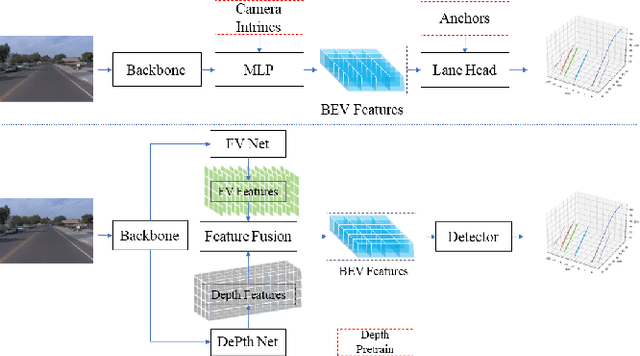

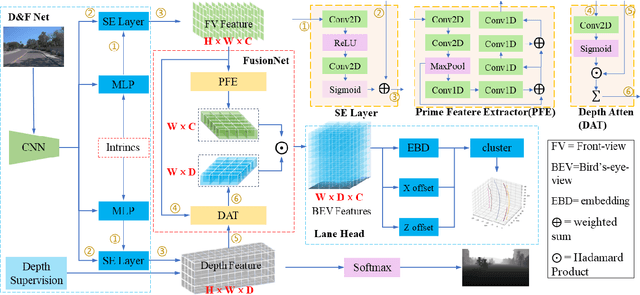
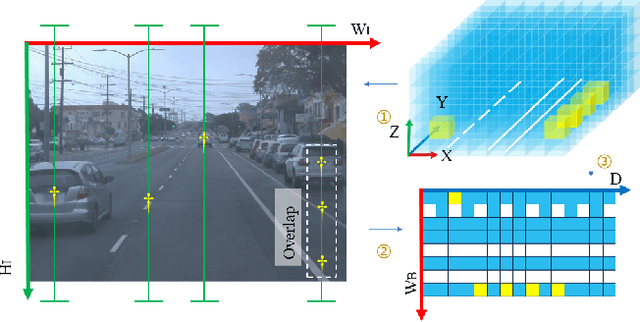
Abstract:3D Lane detection plays an important role in autonomous driving. Recent advances primarily build Birds-Eye-View (BEV) feature from front-view (FV) images to perceive 3D information of Lane more effectively. However, constructing accurate BEV information from FV image is limited due to the lacking of depth information, causing previous works often rely heavily on the assumption of a flat ground plane. Leveraging monocular depth estimation to assist in constructing BEV features is less constrained, but existing methods struggle to effectively integrate the two tasks. To address the above issue, in this paper, an accurate 3D lane detection method based on depth-aware BEV feature transtormation is proposed. In detail, an effective feature extraction module is designed, in which a Depth Net is integrated to obtain the vital depth information for 3D perception, thereby simplifying the complexity of view transformation. Subquently a feature reduce module is proposed to reduce height dimension of FV features and depth features, thereby enables effective fusion of crucial FV features and depth features. Then a fusion module is designed to build BEV feature from prime FV feature and depth information. The proposed method performs comparably with state-of-the-art methods on both synthetic Apollo, realistic OpenLane datasets.
 Add to Chrome
Add to Chrome Add to Firefox
Add to Firefox Add to Edge
Add to Edge